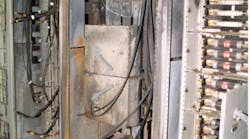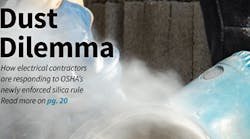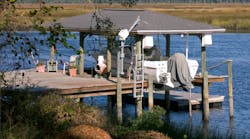The armchair forensic engineers have spoken, and the gameplan calls for patience and care
In April we switched up our usual format to give you an opportunity to review the details of an electrical accident and offer your opinion as to how to handle the situation. If you'll remember, an electrician was injured while installing a new feeder in a shopping mall's 480V distribution equipment main switchboard. We asked you to step into the shoes of the forensic engineer and the electrical contractor hired to perform the emergency repairs and tell us what you would do.
Those who chose to take that walk ranged in profession from electrician to engineering professor. Some had forensic related experience, some didn't. One engineer even represented a building owner in a similar situation. Let's first review their thoughts and perspectives and then discuss the actual outcome.
After the electrician received medical treatment, the mall manager's first concern was to restore power; 25% of the stores were closed because of the power outage.
A local electrical contractor was called in to perform emergency repairs. As noted in April, the need for quick action on the part of the electrical contractor must be weighed against the need to preserve the scene of the accident for investigative purposes. Those who responded took both of those issues into consideration when suggesting the following advice for the contractor:
-
Get instructions in writing, including a “hold-harmless” agreement for “evidence spoilation.” Inform the owner of possible legal consequences of proceeding with the demolition of the damaged electrical equipment. Legal action against any party that alters or destroys evidence in these cases has become more prevalent.
-
Wait for the insurance investigator, or forensic engineer, to arrive before dismantling damaged equipment.
-
Document everything. Take photographs and video of the equipment.
-
Assume that there are other parties, besides the mall management and owners, that have an interest in determining what happened. These parties have the right to inspect the damaged equipment before it's altered or dismantled.
-
Develop an emergency power plan, such as the implementation of portable generators or alternate feeds, that bypass the damaged switchboard. It may be more expensive up front, but it will cost less than the legal costs of defending an “evidence spoilation” lawsuit later.
-
Assume that someone will be “second-guessing” your decisions and actions related to the repair methods that may affect the damaged equipment.
The next party to arrive on the site will typically be a forensic engineer representing the mall management. As with the electrical contractor, the engineer must document the accident with photos and take care to preserve the scene. Beyond those responsibilities, though, our respondents offered the following additional advice:
-
Immediately request that all emergency repair work stop. Review the contractor's action plan and plans for proceeding.
-
Schedule a conference call immediately with the mall manager, the mall's insurance adjuster, and the attorney representing the mall's insurance company to discuss your recommended course of action. You may not have authority to stop the contractor from removing the damaged switchboard, but you may convince others of the wisdom in doing so.
-
Like the electrical contractor, consider the rights of the other parties to the investigation, including the electrician's insurance company, the switchboard manufacturer, the electric utility, and the contractor that originally installed the switchboard. Also bear in mind that the city electrical inspector or an OSHA inspector may want to investigate.
-
Although your decisions regarding the repair of the damaged equipment will be subject to the review of the other parties, someone has to make the tough decisions, and the forensic engineer is typically in the best position to do so.
-
Ensure that when the decision is made to disassemble the damaged switchboard that the items are “tagged and bagged.” Each item needs to be photographed and identified as it's removed.
-
Even though you were retained on behalf of the mall's insurance carrier, remember that the mall management's objectives during the emergency repair phase of work may be contrary to yours.
-
Use the principals for investigation of an incident outlined in the current edition of NFPA 921, Guide for Fire and Explosion Investigations.
-
Conduct interviews with all witnesses at the site in conjunction with all interested parties. Recognize that for legal considerations, employees of companies that may be involved in future litigation may not be made available.
As the forensic engineer working on behalf of the mall, it will probably be your job to determine the circumstances and events that led to the arc-fault incident and the resulting injury to the electrician. Keep in mind that the other parties involved may also retain their own investigative teams, so you'll have to consider the following issues offered by our respondents that may arise:
-
What were the electrician's qualifications and experience?
-
What personal protective equipment, if any, did the electrician use?
-
Could the work have been performed after hours with the switchboard de-energized?
-
What was the switchboard's preventive maintenance history?
-
Was there a protective device coordination problem that failed to limit the initial arc fault?
-
Were the injured electrician's burns consistent with his statement and those of the witnesses regarding his actions preceding the arc-fault incident?
-
Were there any pre-existing conditions associated with the main switchboard that could have contributed to or caused the arc-fault incident?
Theory becomes practice.
The accident introduced in Part I involved several of the issues noted by the respondents. The damaged electrical switchboard had been removed before everyone had a chance to see it. This often occurs because it isn't practical to delay repairs long enough to give all interested parties a chance to survey the scene.
The electrician contended that he wasn't at fault for the arc-fault incident. Instead, his lawyer argued, the arc flash was caused by pre-existing conditions of the equipment on which he was working.
As one respondent surmised, a problem with the protective device that should have prevented — or at least mitigated — the arc-flash event actually allowed the initial arc fault to propagate into the full-blown event that injured the electrician. As a result, the protective device manufacturer was also included in his lawsuit.
After the electrician and his lawyer filed suit, three forensic engineers investigated the incident on behalf of three parties. They wrote their reports and were deposed, and the matter was resolved with a confidential settlement.
The fact that the judgement and court documents were sealed is a matter for the courts. The lessons to be learned from this case — and from the readers who answered our call — are applicable in almost all cases of electric shock or electrocution. It's rare when only one party is called in to investigate the accident, so respecting the integrity of the scene is not only courteous but necessary to the investigation. Most importantly, conducting a thorough, responsible investigation takes precedence to getting things up and running.
Foley is president of Technical Consultants Group, Ltd., Denver.
Read on for the full text of the respondents' suggestions.




